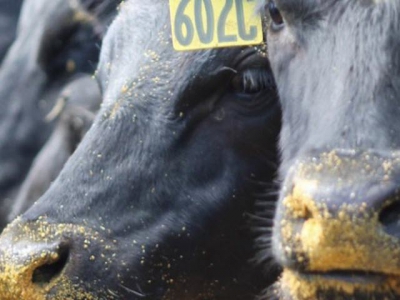Progressive limit feeding may maximize cattle profits

Progressive limit feeding works in theory, but new study being set up to show if it works in practice.
Beef cattle producers could see greater profits in the finishing period with progressive limit feeding, according to research from University of Illinois scientists.
To help keep cattle healthy as they enter a feedlot, producers often feed less, or “limit feed,” for a short time to allow the animals to adjust to the feedlot diet. The new research looks at the concept of progressively reducing feed intake throughout the diet transition period with the goal of maintaining a constant body size, the university said in an announcement.
Feeding previously growing animals this way causes their internal organs to shrink, which reduces their maintenance requirement, the researchers said, noting that this means that they require less feed and cost less. When animals are transitioned back to ad libitum feeding, compensatory growth allows them to grow more on less feed, ultimately saving producers money, they added.
“Producers commonly lower intake when animals come into a feedlot anyway, but no one knew how this should be done to maximize profit. What we’ve done is quantify how much and how long they should limit feed to maximize their return at slaughter, using real dollars and cents for feed and beef prices,” said study co-author Michael Murphy, an emeritus professor in the University of Illinois department of animal sciences.
Murphy and co-author Bruce Hannon, emeritus professor in the department of geography and geographic information science, applied a custom-built mathematical formula to a real data set of beef cattle growth in a feedlot. They determined that progressive limit feeding could save enough money that producers could market cattle at a slightly lighter weight but with greater profit, the announcement said.
“When people limit feed, they often feel they have to keep animals in the feedlot an extra week or two until they get to the size they wanted, but that incurs an opportunity cost because they’re not bringing a new group of animals in during that time, and they’re also delaying their income,” Murphy said. "So, even if they get a slightly lower price for a lighter-weight market animal, they make it up by avoiding that opportunity cost and spending less on feed overall.”
Murphy said the length of time producers should use progressive limit feeding to maximize profit will depend on the market prices for feedstuffs and carcasses.
“We took five years of market variability to come up with a practical scenario for how profit could be affected. We looked at our results as kind of an upper bound on the profit effect,” he said.
Importantly, the analysis suggests that profits and carcass quality reach their peak when limit feeding takes place at the beginning of the finishing period, the announcement said.
According to the university, Murphy and Hannon’s work indicates that progressive limit feeding works in theory; the next step is to show that it works in practice. Dan Shike and Josh McCann, both in the University of Illinois department of animal sciences, are currently setting up an experiment to do just that.
“Our research suggests it’s worth a try. It should be easy to implement and practical in current feedlot systems. It just takes advantage of the biology in a way that would be most efficient,” Murphy said.
Có thể bạn quan tâm
 Adding lysine to dairy cow diets may improve intake during transition
Adding lysine to dairy cow diets may improve intake during transition Supplementing dairy cows with rumen-protected lysine may improve cow intake during the transition period and reduce free fatty acids and β-hydroxybutyrate
 Varying feed pellet size, binder use may support cattle feed intake, production
Varying feed pellet size, binder use may support cattle feed intake, production Increasing feed pellet size and adding binding agents may support cattle intake and weight gain during winter production and could improve ruminal fermentation,
 Hike in concentrated feed use in increasingly consolidated Chinese dairy sector
Hike in concentrated feed use in increasingly consolidated Chinese dairy sector Consolidated dairy farm operations now account for a larger portion of overall milk production in China, finds a USDA report.